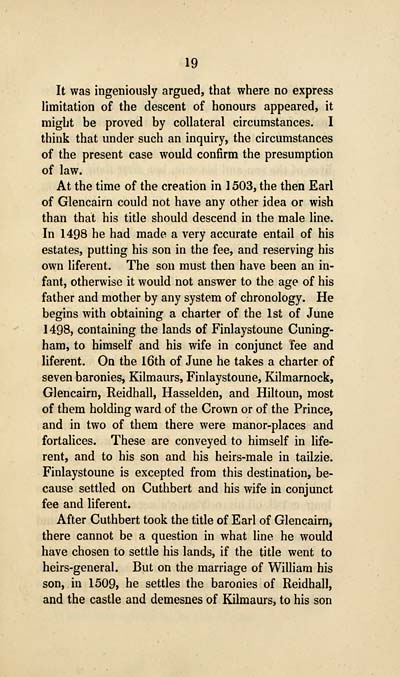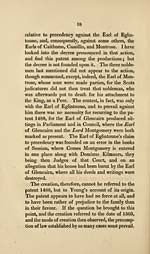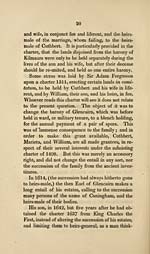Reports of claims preferred to the House of Lords in the cases of the Cassillis, Sutherland, Spynie, and Glencairn peerages
(161) Page 19
Download files
Complete book:
Individual page:
Thumbnail gallery: Grid view | List view

19
It was ingeniously argued, that where no express
limitation of the descent of honours appeared, it
might be proved by collateral circumstances. I
think that under such an inquiry, the circumstances
of the present case would confirm the presumption
of law.
At the time of the creation in 1503, the then Earl
of Glencairn could not have any other idea or wish
than that his title should descend in the male line.
In 1498 he had made a very accurate entail of his
estates, putting his son in the fee, and reserving his
own liferent. The son must then have been an in-
fant, otherwise it would not answer to the age of his
father and mother by any system of chronology. He
begins with obtaining a charter of the 1st of June
1 498, containing the lands of Finlaystoune Cuning-
ham, to himself and his wife in conjunct fee and
liferent. On the 16th of June he takes a charter of
seven baronies, Kilmaurs, Finlaystoune, Kilmarnock,
Glencairn, Reidhall, Hasselden, and Hiltoun, most
of them holding ward of the Crown or of the Prince,
and in two of them there were manor-places and
fortalices. These are conveyed to himself in life-
rent, and to his son and his heirs-male in tailzie.
Finlaystoune is excepted from this destination, be-
cause settled on Cuthbert and his wife in conjunct
fee and liferent.
After Cuthbert took the title of Earl of Glencairn,
there cannot be a question in what line he would
have chosen to settle his lands, if the title went to
heirs-general. But on the marriage of William his
son, in 1509, he settles the baronies of Reidhall,
and the castle and demesnes of Kilmaurs, to his son
It was ingeniously argued, that where no express
limitation of the descent of honours appeared, it
might be proved by collateral circumstances. I
think that under such an inquiry, the circumstances
of the present case would confirm the presumption
of law.
At the time of the creation in 1503, the then Earl
of Glencairn could not have any other idea or wish
than that his title should descend in the male line.
In 1498 he had made a very accurate entail of his
estates, putting his son in the fee, and reserving his
own liferent. The son must then have been an in-
fant, otherwise it would not answer to the age of his
father and mother by any system of chronology. He
begins with obtaining a charter of the 1st of June
1 498, containing the lands of Finlaystoune Cuning-
ham, to himself and his wife in conjunct fee and
liferent. On the 16th of June he takes a charter of
seven baronies, Kilmaurs, Finlaystoune, Kilmarnock,
Glencairn, Reidhall, Hasselden, and Hiltoun, most
of them holding ward of the Crown or of the Prince,
and in two of them there were manor-places and
fortalices. These are conveyed to himself in life-
rent, and to his son and his heirs-male in tailzie.
Finlaystoune is excepted from this destination, be-
cause settled on Cuthbert and his wife in conjunct
fee and liferent.
After Cuthbert took the title of Earl of Glencairn,
there cannot be a question in what line he would
have chosen to settle his lands, if the title went to
heirs-general. But on the marriage of William his
son, in 1509, he settles the baronies of Reidhall,
and the castle and demesnes of Kilmaurs, to his son
Set display mode to:
![]() Universal Viewer |
Universal Viewer | ![]() Mirador |
Large image | Transcription
Mirador |
Large image | Transcription
Images and transcriptions on this page, including medium image downloads, may be used under the Creative Commons Attribution 4.0 International Licence unless otherwise stated. ![]()
| Histories of Scottish families > Reports of claims preferred to the House of Lords in the cases of the Cassillis, Sutherland, Spynie, and Glencairn peerages > (161) Page 19 |
|---|
| Permanent URL | https://digital.nls.uk/95013834 |
|---|
| Description | A selection of almost 400 printed items relating to the history of Scottish families, mostly dating from the 19th and early 20th centuries. Includes memoirs, genealogies and clan histories, with a few produced by emigrant families. The earliest family history goes back to AD 916. |
|---|

